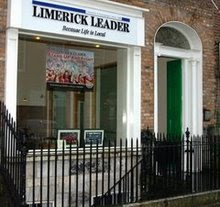THOUSANDS of Limerick GAA followers will travel to Croke Park this Sunday, but unfortunatey not all are aware that a Limerick man is responsible for what is now a world-class stadium.
A new book published in the last week tells the story that all Limerick GAA supporters should hold dear to their hearts.
It’s all too often that we criticise the work of GAA officialdom and perhaps we only see their valued work when they depart the scene.
Frank Brazil Dineen is certainly one GAA official that should not be forgotten in Limerick.
‘Frank Brazil Dinneen - The Patriot who purchased Croke Park’ has been released to coincide with Ballylanders GAA club’s 125-year celebrations and their commemoration of their founding member as part of their annual Pattern Day Festival.
The 160-page publication was written by Harry Greensymth.
Best remembered
While Frank B. Dineen is best remembered for his role in the administration of the GAA, the book also tells of of his process as an athlete and the role he played with the IRB (Irish Republican Brotherhood).
There is also a chapter donated to a variety of local verse about Dinnen, Ballylanders, Glenroe and the Ballyhoura region.
Frank Dineen was the son of Nicholas Dineen and Mary Brazil.
He was born on December 28 1862. He first came to prominence as an athlete holding the Irish record for the 100 yards sprint and high jump in the 1880s.
Locally, the book tells of how he was among the founders of the Ballylanders Shamrocks Football Club in 1886 and soon he became involved at County Board level in Limerick while also attending the Annual Congress of the GAA.
In 1889 he was appointed as secretary of the GAA for a two-year period and then in 1895 he was elected president of the GAA - a position he held until 1898.
He remains the only person to have held the two most powerful positions within the GAA.
After his departure as President, Dineen remained central figure within the GAA.
A journalist by trade, he was the athletic editor of Sport which was published by the Freeman’s Journal and Dineen played a large role in increasing the popularity of the GAA through his writings.
In 1906 he was the first president of the Athletic Council and published the Irish Athletic Record in 1906.
While serving as president and secretary made him unique, his true value to the GAA was yet to come.
The site upon which Croke Park now stands was originally owned by Maurice Butterly in the 1870s and was known as the City and Suburban Sports Grounds.
The GAA were one of its most frequent users and in 1906 it was Frank Dineen’s wish that the GAA purchase the grounds as a permanent home.
He got the go ahead from Congress, but this decision was then over-turned when it was felt that the price was too high.
Dineen still persisted and on December 17, 1908 he paid £3,250 for the 14-acre site.
Immediately he made improvements to the grounds (again out of his own pocket) and in the seven years after he purchased the grounds, all but one of the All-Ireland hurling and football finals were played there - for much of the previous 20 years a variety of venues had been used across the country.
In 1913 the GAA bought the site from Frank, for the princely sum of £3,500, leaving Dineen at a substantial loss considering the improvements he had made.
Even after this, Dineen was instrumental in the renaming of the grounds ‘Croke Park’, in honour of the associations first patron Archbishop Croke of Cashel.
‘Frank Brazil Dinneen - The Patriot who purchased Croke Park’ by Harry Greensmyth is available from all business premises in Ballylanders for €20.
Wednesday, August 12, 2009
Subscribe to:
Post Comments (Atom)




0 comments:
Post a Comment